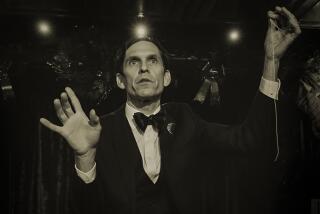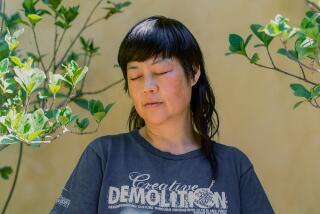Haunted by Such Human Tales
NEW YORK — “ ‘Kwaidan’ is a project I’ve wanted to do for 20 years,” theater director Ping Chong says of the famous collection of traditional Japanese ghost stories, four of which were made into the 1964 film “Kwaidan.” “I saw the film, then I read the book.”
He was drawn to the stories, he has said, “because of the profoundly human themes embodied in them: the longing for redemption, the inability to surrender pain and the loss of the past, love lost and regained, the consequences of time wrought upon human existence.”
In 1988, he presented one story, “The Woman of the Snow,” as part of a theatrical anthology, but he continued to dream of an entire work based on the material. In the mid-1990s, Chong was invited by Atlanta’s Center for Puppetry Arts to create a program, and he knew immediately what he would do--”Kwaidan.”
It took some five years for him and his production company, Ping Chong & Company, to pull together the funding. After working with the center for eight months, the production premiered in Atlanta in June 1998. Since then, the show has been performed to sold-out houses from New York to London, as well as Japan. “Kwaidan” comes to UCLA’s Freud Playhouse Nov. 30-Dec. 3.
Chong, who this year received an Obie award--his second--for sustained achievement, has created some 50 productions, a number exploring East-West themes, including “Deshima” in 1990, “Chinoiserie” in 1995 and “After Sorrow” in 1998. But “Kwaidan” is his first full-length production featuring puppetry.
Sitting in a quiet coffee shop near Chinatown in New York City, the intense, wiry director recalls the process of creating “Kwaidan,” which the New York Times praised for “the inventiveness of the storytelling” and “the extravagant art and artfulness of its set.”
“You have to storyboard the whole thing,” he explains. “You have to design the scale of the puppets. Everything is pre-planned except the gestural language of the puppets because each puppet has limitations and strengths, which you don’t know until you have them.”
*
Experts at the Center for Puppetry Arts, led by artistic director Jon Ludwig, figured out what kinds of puppets to use and how to construct them. (The “Kwaidan” puppets are operated by sticks from below.)
Recognizing the need for some cultural authenticity, Chong brought in a Japanese designer, Mitsuru Ishii. “I know Japanese are very picky about accuracy,” he says. “I didn’t do ‘Deshima’ with Japanese consultants, so when we brought it to Japan, there were some criticisms--costumes and stuff like that. I think it’s a good idea when you’re dealing with a culture that’s not yours that you do bring some consultant on because you can be making all kinds of ridiculous mistakes otherwise.”
At the same time, he makes it clear that he did not look to Japanese traditions of theater, whether bunraku or Kabuki, for his staging. In fact, he introduced slightly different techniques to tell each story, pulling out almost every available theatrical ploy to engage the audience--varying scales of puppets, unusual angles of view, light projection, and haunting sound effects.
*
Born in Toronto and raised not far from New York’s Chinatown, Chong graduated in 1969 from the School of Visual Arts in New York with a film degree. But he didn’t go into film, he says, because “there were no Chinese filmmakers in ‘69, so back then it would have been a major long shot to do that. It’s a very aggressive business by and large--I was 24 when I graduated, and I didn’t have the confidence to do that.”
So, Chong says, “I decided to take dance, just to give myself some time to figure what I wanted to do next.” He took lessons from Meredith Monk, who eventually invited him to join her workshop. A year later, he was a member of her dance company.
“Back in those days, dance was more experimental, and they were looking for people who were natural movers--who were not technique-based people, so it was somewhere between performance and dance. That’s how it all began for me.”
Chong was with the company from 1972 to 1978, gradually becoming a collaborator as well as a performer. Eventually, he began to produce his own theatrical pieces--a combination of dance and drama. His early works tended to be abstract and even nonlinear (“A.M./A.M.--The Articulated Man” and “Angels of Swedenborg”). But in 1990, he began to produce more historically based works, incorporating real people and events, resulting in “Deshima.” During the centuries when Japan was closed to the West, Deshima was the island where the Japanese permitted early Dutch traders and missionaries to land. In an overarching way, “Deshima” was a chance for Chong to address issues of East-West relationships and identities.
Moving into puppetry felt natural, he says. He had used puppets in his early works, in the 1970s, though not in the ‘80s or ‘90s. “My background is as a visual artist,” he says, “and as a visual artist, you’re used to controlling everything. So in that sense, making ‘Kwaidan’ is closer to being back to my roots as being a visual artist.”
“Jikininki”--”Kwaidan’s” first section, about a possessed Buddhist priest--opens on three window-like panels. Across them, a large black crow flies over a mountain landscape, and a traveler who picks his way along a path grows larger by the time he reaches a wayside hut in the right panel. By changing the scale of the puppet, Chong transits from what is the equivalent of a long shot in film to a medium shot. Later, a ghost is represented by a parabolic play of light. Such cinematic devices are used throughout the pieces, innovations he credits mostly to his film training.
“Nobody had done that in puppetry before,” he says of a couple of scenes shown from the top down--an overhead shot, so to speak. “That’s where it’s an advantage to bring in an artist into a field that is not his field--some of the most interesting theater people are people who didn’t come from theater, like myself. I brought a lot of my film background to use.”
*
In another story, “Miminashi Hoichi,” the blind priest Hoichi is played by a person, the other characters played by puppets, while a demon is portrayed by a fierce pair of eyes glowing in the background. Hoichi has been summoned by the demon to play for an unknown audience, a well-behaved and most appreciative audience that wants him to sing of the epic and tragic battle between two rival clans. However, this audience turns out to be one from the nether world.
While “Jikininki” and “Miminashi Hoichi” provided enough material for a good staging, the third, “O-Tei,” was only two pages in the original, so Chong had to expand it. Here, Chosei’s beloved is dying of consumption, and at her deathbed, she promises that they will meet again, 15 or 16 years hence. To move from a traditional Japan to a modern one, a sometimes poignant, sometimes hilarious montage is flashed onto three circular screens. An old-fashioned radio becomes a television, a tray of sushi becomes a hamburger, a caterpillar becomes a butterfly, and an infant’s hand becomes a wrinkled one.
“Of course it was a lot of fun doing that,” the director says with a smile. After the montage, we find ourselves in a noisy station where an older Chosei boards a super-speedy bullet train. At his destination, he goes into a McDonald’s--the director admits that time lapse has taken some artistic license here--where he finally finds his long-lost love.
“The original story didn’t move to the present,” Chong says. “I was interested in doing that because the first two stories set up a Japan that we have an image of, a stereotype of, when in fact the Japan of today is not that way at all, so it really is a comment about the world as well, the changing world.”
*
“KWAIDAN: Three Japanese Ghost Stories,” UCLA’s Freud Playhouse, Westwood. Dates: Opens Nov. 30. Thursday-Saturday, 8 p.m.; Saturday-Sunday, 2 p.m. Ends Dec. 3. Price: $40. Phone: (310) 825-2101.
More to Read
The biggest entertainment stories
Get our big stories about Hollywood, film, television, music, arts, culture and more right in your inbox as soon as they publish.
You may occasionally receive promotional content from the Los Angeles Times.










